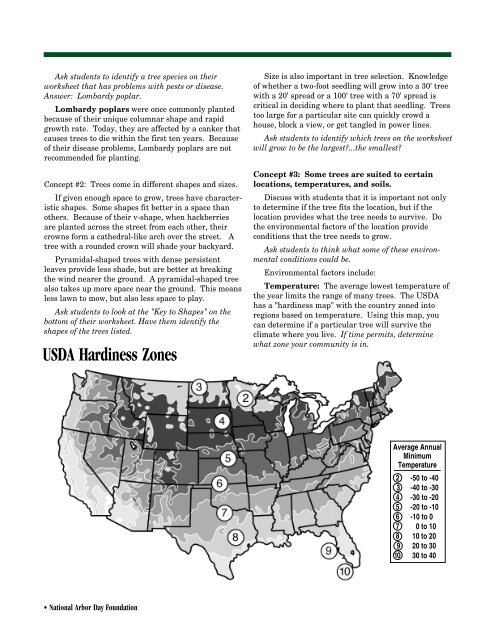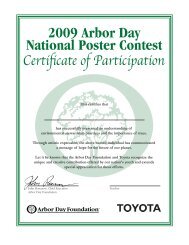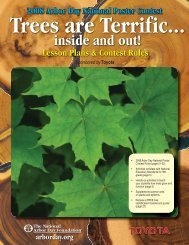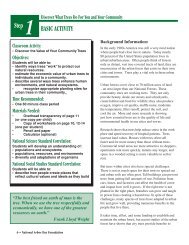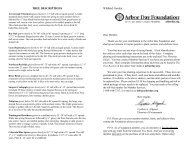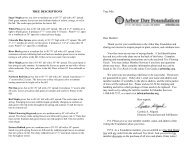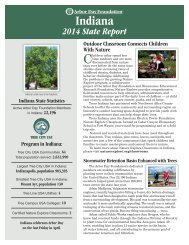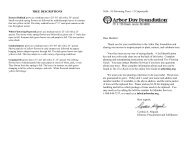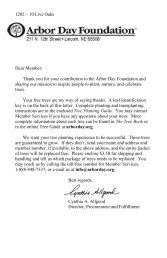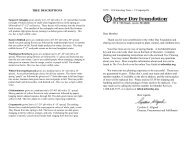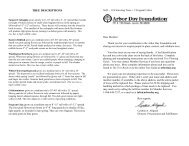Tree Diversity Activity - Arbor Day Foundation
Tree Diversity Activity - Arbor Day Foundation
Tree Diversity Activity - Arbor Day Foundation
You also want an ePaper? Increase the reach of your titles
YUMPU automatically turns print PDFs into web optimized ePapers that Google loves.
Ask students to identify a tree species on their<br />
worksheet that has problems with pests or disease.<br />
Answer: Lombardy poplar.<br />
Lombardy poplars were once commonly planted<br />
because of their unique columnar shape and rapid<br />
growth rate. Today, they are affected by a canker that<br />
causes trees to die within the first ten years. Because<br />
of their disease problems, Lombardy poplars are not<br />
recommended for planting.<br />
Concept #2: <strong>Tree</strong>s come in different shapes and sizes.<br />
If given enough space to grow, trees have characteristic<br />
shapes. Some shapes fit better in a space than<br />
others. Because of their v-shape, when hackberries<br />
are planted across the street from each other, their<br />
crowns form a cathedral-like arch over the street. A<br />
tree with a rounded crown will shade your backyard.<br />
Pyramidal-shaped trees with dense persistent<br />
leaves provide less shade, but are better at breaking<br />
the wind nearer the ground. A pyramidal-shaped tree<br />
also takes up more space near the ground. This means<br />
less lawn to mow, but also less space to play.<br />
Ask students to look at the "Key to Shapes" on the<br />
bottom of their worksheet. Have them identify the<br />
shapes of the trees listed.<br />
USDA Hardiness Zones<br />
Size is also important in tree selection. Knowledge<br />
of whether a two-foot seedling will grow into a 30' tree<br />
with a 20' spread or a 100' tree with a 70' spread is<br />
critical in deciding where to plant that seedling. <strong>Tree</strong>s<br />
too large for a particular site can quickly crowd a<br />
house, block a view, or get tangled in power lines.<br />
Ask students to identify which trees on the worksheet<br />
will grow to be the largest?...the smallest?<br />
Concept #3: Some trees are suited to certain<br />
locations, temperatures, and soils.<br />
Discuss with students that it is important not only<br />
to determine if the tree fits the location, but if the<br />
location provides what the tree needs to survive. Do<br />
the environmental factors of the location provide<br />
conditions that the tree needs to grow.<br />
Ask students to think what some of these environmental<br />
conditions could be.<br />
Environmental factors include:<br />
Temperature: The average lowest temperature of<br />
the year limits the range of many trees. The USDA<br />
has a "hardiness map" with the country zoned into<br />
regions based on temperature. Using this map, you<br />
can determine if a particular tree will survive the<br />
climate where you live. If time permits, determine<br />
what zone your community is in.<br />
Average Annual<br />
Minimum<br />
Temperature<br />
2 -50 to -40<br />
3 -40 to -30<br />
4 -30 to -20<br />
5 -20 to -10<br />
6 -10 to 0<br />
7 0 to 10<br />
8 10 to 20<br />
9 20 to 30<br />
10 30 to 40<br />
• National <strong>Arbor</strong> <strong>Day</strong> <strong>Foundation</strong>


